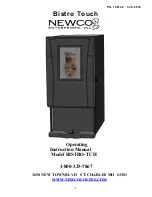
Powermax125
Service Manual 808070
115
8 – Troubleshooting and System Tests
External inspection
1.
Inspect the exterior of the power supply for damage to the cover and external components, such as the power cord
and plug.
2.
Inspect the torch and the torch lead for damage.
3.
Inspect the consumables for damage or wear.
4.
Repair or replace components as necessary.
Internal inspection
1.
Turn OFF (
O
) the power, disconnect the electrical power, and disconnect the gas supply.
2.
Remove the power supply handle and cover. (See
3.
Remove the component barrier. (See
4.
Inspect the inside of the power supply, especially on the side with the power board. Look for broken or loose wiring
connections, burn and char marks, damaged components, and so on.
5.
Repair or replace components as necessary.
Initial resistance check
All resistance values must be taken with the power cord disconnected and all internal power supply wires attached.
Perform the steps in
(above) before continuing in this section.
The type of multimeter you use significantly affects the results of the tests in this section. The resistance values in this
manual are intended as a general reference point.
If resistance values indicate a problem based on the range of values provided in this section, isolate the problem by
removing wires attached to the resistance check points or component until the problem is found.
After the problem is located and repaired, see
on page 112 to test the power supply for
proper operation.
Check the power switch
1.
Set power switch to OFF (
O
), disconnect the electrical power and torch, and then set the power switch (S1) to ON
(
I
).
2.
Check the resistance across the input leads (the leads are labeled L1, L2, and L3 on the power switch).
480 V CSA, 600 V CSA: resistance across the input leads = 400 kΩ.
400 V CE, 380 V CCC: resistance across the input leads = 350 kΩ.
















































